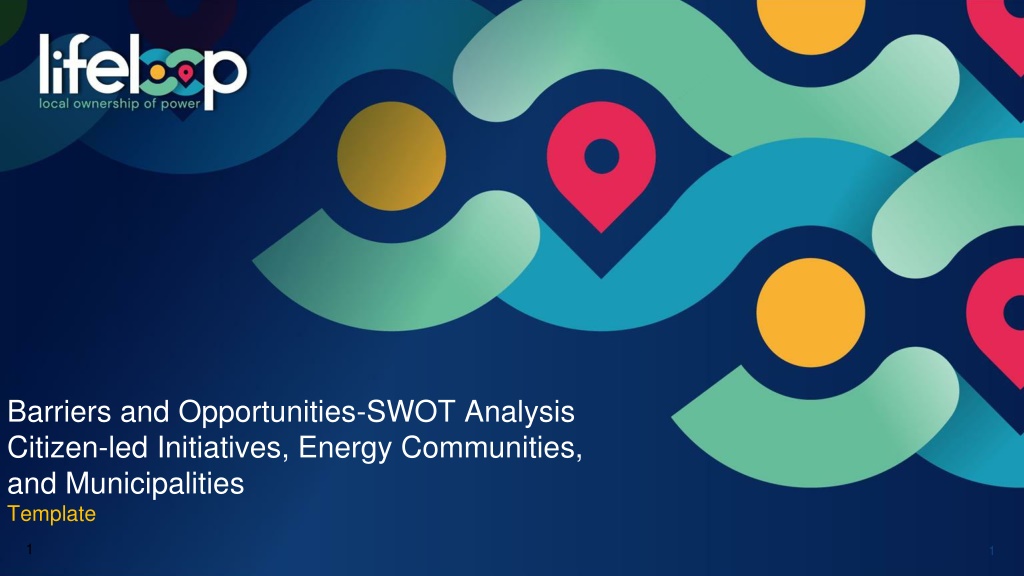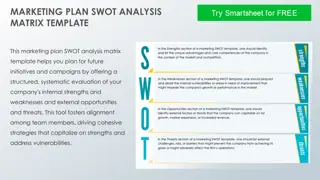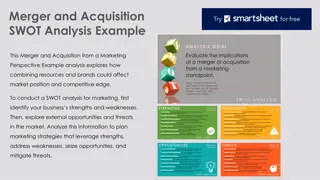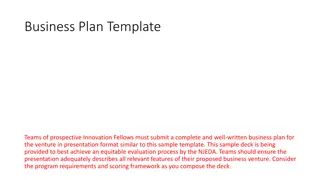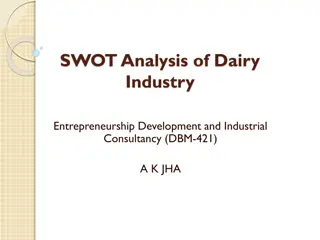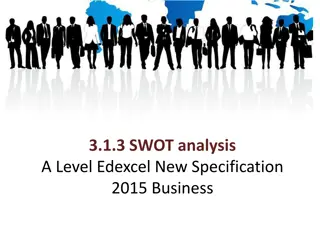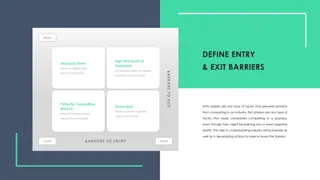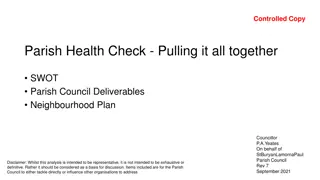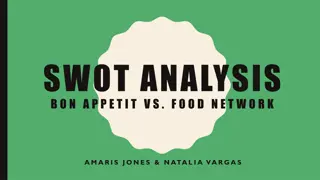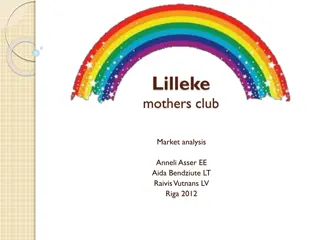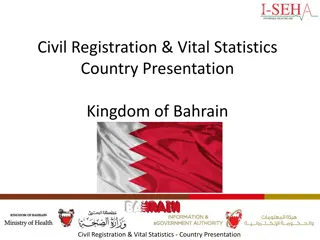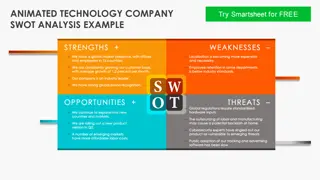Analyzing Barriers and Opportunities in Community Energy Projects: SWOT Analysis Template
Community energy projects with a focus on collaboration between Energy Communities and local municipalities face both obstacles and prospects. Understanding and addressing these barriers and opportunities are crucial for successful project implementation and maximizing benefits for local economies and societies.
Download Presentation

Please find below an Image/Link to download the presentation.
The content on the website is provided AS IS for your information and personal use only. It may not be sold, licensed, or shared on other websites without obtaining consent from the author. Download presentation by click this link. If you encounter any issues during the download, it is possible that the publisher has removed the file from their server.
E N D
Presentation Transcript
Barriers and Opportunities-SWOT Analysis Citizen-led Initiatives, Energy Communities, and Municipalities Template 1 1
Project Name LIFE LOOP Energy Communities Local Ownership of Power Grant Agreement 101077085 Project Duration 2022-2025 Project Coordinator Energy Cities Working Package WP5 Deliverable D5.2 Set of Templates Responsible Partner Electra Energy Cooperative Disclaimer The sole responsibility of this publication lies with the authors and reflects only the authors view. Views and opinions expressed do not necessarily reflect those of the European Commission or CINEA. Neither the European Union nor the granting authority can be held responsible for them. The LIFE LOOP Consortium as a whole nor any individual party, does not offer any assurance that the information presented in this document is suitable for immediate use and will accept no liability for any loss or damage experienced by any person and/or entity using this information. 2 This project has received funding from the European Union s LIFE programme under grant agreement No 101077085
Introductory Remarks In Europe, as well as worldwide, community energy projects are increasingly gaining attention and being recognized as the practical solution for achieving a democratic, inclusive, and sustainable energy transition, with citizens and local communities at its core. Energy Communities significantly contribute to the increase of investments in local renewable energy projects while ensuring the social acceptance of these projects. Moreover, citizen-led initiatives and Energy Communities, with a strong connection to the local environment, implement their projects with due caution over the protection of the local environment and achieve the desired balance between renewable energy and environmental protection. To achieve these goals, it is crucial that these projects are primarily led by local citizens and small to medium enterprises, with active support and/or participation of the local public authorities. This collaboration maximizes the benefits of clean energy production on the local economy and society. By working together, municipalities and Energy Communities can access a range of valuable and diverse resources, such as engaging local communities, mobilizing local capital, accessing specialized networks, and utilizing a wide range of capacities and skills. Additionally, municipalities can mobilize local communities in various ways, access public funds, land, networks, and develop strategies and supportive policies. While local municipalities have committed to energy, climate, and environmental goals, achieving them can be challenging, especially without the support and involvement of local citizens. This also highlights the common ground shared by Energy Communities and municipalities. Therefore, establishing stable and productive cooperation between these parties can produce benefits to both, as well as for the wider local community. Despite the potential benefits, cooperation between Energy Communities and local municipalities in developing community energy projects can face various obstacles. Therefore, identifying and analyzing the barriers and opportunities can help you better prepare to overcome the identified barriers and maximize the identified opportunities. 3 This project has received funding from the European Union s LIFE programme under grant agreement No 101077085
The SWOT analysis model, which evaluates the Strengths, Weaknesses, Opportunities, and Threats (SWOT) of an organization or project, serves as the basis for the following template to analyze the opportunities and barriers of community energy projects, with a particular focus on the cooperation with local public authorities. How to use this template Please note that this template is intended to provide guidance and establish the core points of analysis of opportunities and barriers following the model of SWOT analysis. The readers and users should tailor the following analysis to fit the Energy Community s needs and situation, therefore, based on the information and directions provided, you can design your SWOT analysis to meet your local needs, reflect the local situation, and identify the local barriers and opportunities when attempting to engage with the local municipalities. Image Source: Freepik 4 This project has received funding from the European Union s LIFE programme under grant agreement No 101077085
Part I: SWOT Analysis - Overview A SWOT analysis is an assessment of the internal factors (strengths and weaknesses) and external factors (opportunities and threats) that may have an impact on your community energy project. The primary goal of conducting a SWOT analysis is to assist your Energy Community in gaining a complete understanding of all the factors involved in making a decision and implementing a project. It is recommended to conduct a SWOT analysis particularly before initiating any project, and when starting a new collaboration. Therefore, a SWOT analysis can be an effective tool for an Energy Community to identify and assess the important factors for every potential project, and specifically its: Strengths: The SWOT analysis can help an Energy Community identify its strengths, such as unique assets, skills, and capabilities. This can help the Energy Community build on its strengths and create an advantage. Weaknesses: Moreover, it can help an Energy Community identify its weaknesses, such as its lack of resources, skills, or capacity to achieve its goals. This can help the Energy Community address the identified weaknesses and improve its members' skills and operation. Opportunities: The SWOT analysis can also help your Energy Community identify new opportunities, such as emerging technologies, policies, funding sources, or collaborations. By identifying opportunities, Energy Communities can leverage them to develop new strategies and partnerships that can be practically implemented to achieve their goals. Threats and Barriers: Through the SWOT analysis, your Energy Community will also be able to identify threats and barriers to its development and projects. In this way, you will be prepared for potential threats and barriers, and you can further develop contingency plans to mitigate their impact or even prevent them. 5 This project has received funding from the European Union s LIFE programme under grant agreement No 101077085
Part II: SWOT Analysis Energy Community and Citizen-led Initiatives A key step in the planning process to assess the project feasibility and identify potential obstacles and risks is the SWOT analysis. By conducting a SWOT analysis, citizen-led initiatives and Energy Communities can identify in advance some of the internal and external factors that may affect the project's success and thereby adjust its planning process, and develop alternative strategies to achieve its goals and address challenges. In other words, the SWOT analysis can serve as a useful tool to explore new possibilities or solutions to problems, make informed decisions about the most suitable direction for your citizen-led initiative/Energy Community, identify areas where change is possible, and adjust and refine plans if needed during the implementation process. The table below illustrates an example of how to identify and categorize both internal and external factors that could potentially impact your Energy Community's project. 6 This project has received funding from the European Union s LIFE programme under grant agreement No 101077085
Dedicated Community Members Lack of Knowledge and Skills, Time and Expertise Access to Renewable Energy Sources - Internal Local Potential Limited Community Outreach and Education Community Energy Network Lack of Financial Literacy Network of Supporters and Volunteers Weaknesses Strengths Reliance on External Financing and Strong partnerships with local businesses Funding and organizations Potential Partnerships with Local Lack of Stability and Clarity of Local or Municipalities and Institutions Regional Energy and Climate Policies Threats- Barriers Local, National and EU policies, grants, Opportunities Complexity of Planning and Permitting and subsidies for community energy Procedures of RES Projects Growing Demand for Renewable Energy Grid Saturation in the Region Increased Local Interest on Renewable External Lack of Social Acceptance of RES (local Energy Projects and Community interests, lack of information, etc.) Engagement 7 This project has received funding from the European Union s LIFE programme under grant agreement No 101077085
Part III: SWOT Analysis Community-led Initiatives, Energy Communities, and Municipalities Municipalities, being the closest public authority to the citizens, can play a crucial role in empowering their local citizens and facilitating the development of community energy projects. Moreover, as mentioned before, local municipalities have committed to energy, climate, social and environmental goals, it can be difficult to attain them without the assistance and engagement of local citizens. On the other hand, Energy Communities constitute a vehicle that allows citizens to actively participate in the transition towards sustainable and decentralized energy systems, thereby promoting democratic and inclusive practices. This active engagement not only enhances the chances of the energy transition s success but also strengthens the bond between citizens, their local community and environment, fostering a sense of ownership towards local energy production and responsibility towards the protection of the local environment. In the end, Energy Communities contribute to creating a more participatory and just society, where all members and all genders participate in shaping their local community. All the above mentioned demonstrate the shared objectives of municipalities and energy communities, as they are both actors driven by social and mission-based goals, rather than profit-driven motives. However, when it comes in the actual collaboration between these two entities, various challenges arise. The following tables provide an example of how to identify the opportunities and the barriers of the collaboration between Energy Communities and municipalities, utilizing the SWOT analysis model. This identification process involves assessing the strengths, weaknesses, opportunities, and threats/barriers of each entity s internal and external factors, thus providing a mutual and comprehensive understanding of their respective perspectives on the potential collaboration. By conducting this analysis, Energy Communities can gain insight into the operational procedures of municipalities and better understand the challenges they face when attempting to support community energy projects. This mutual understanding can facilitate and establish a foundation for effective communication between these two entities, as they can engage in productive dialogue based on a common understanding of each other s needs and challenges, therefore seek collaboratively ways to overcome them. 8 This project has received funding from the European Union s LIFE programme under grant agreement No 101077085
Energy Communitys View on Collaboration with Municipalities Lack of Financing to Develop and Implement Community Dedicated and Skilled Community Members Internal Energy Community's Strengths and Weaknesses Energy Projects Development of Renewable Energy Projects with Consideration for Local Environmental Protection Lack of Land for Developing Community Energy Projects Community Energy Network Lack of Financial Literacy Network of Supporters and Volunteers Lack of Effective Communication and Relationship- Strong Partnerships with Local Businesses and Building with Local Community and Municipalities Organizations Lack of Meeting Spaces Weaknesses Strengths Enhance Social Acceptance of RES Lack of Human Resources Alleviation of Energy Poverty Lack and/or Unstable Local and/or Regional Policies and Support Opportunity to Establish a Long-Term Partnership that Schemes for Community Energy Projects Threats and Barriers Opportunities Fosters Effective Collaboration and Shared Goals, Focusing Lack of Trust Towards Local Municipalities on Equal Benefit of all Community Groups and the Entire Lack of Political Vision for Community Energy Projects Local Community Lack of Knowledge, Skills and Expertise to Develop or Support Regulatory and Policy Support to Community Energy Community Energy Projects Projects / Green Public Procurement Lack of Human Resources/No Qualified Staff Access to Public Land and Funding Opportunities and Incumbent Energy Companies Hinder Access to Community Energy Support Schemes Projects External Cooperating with Municipalities Raise Awareness about Energy Communities and Engage Lack of Open and Direct Dialogue between Citizen-led Initiatives, all Community Groups and the Entire Local Community Energy Communities, and City Representatives Foster Trust Between Municipalities and Local Citizens 9 This project has received funding from the European Union s LIFE programme under grant agreement No 101077085
Municipalitys View on Supporting and Collaborating with Energy Communities Lack of Awareness on the Topic of Community Energy Projects /Lack of Sufficient Information Bureaucratic Processes, Complexity, Slow Decision-Making Limited Flexibility in Policy, Regulations and Public Closest Public Authority to Citizens Internal Municipality's Strengths and Weaknesses Access to a Wide Range of Resources, including Funding, Human Resources, and Expertise Ability to Develop and Implement Policies and Procurement Limited Public Engagement and Trust Resistance to the Change Internal Processes Lack of Human Resources/No Qualified Staff Lack of Knowledge, Skills and Expertise to Support and Develop Community Energy Projects Lack of Platforms and Tools to Support People and Organisations involved in Community Energy Projects Regulations Established Local Networks and Partnerships Access to Technical Expertise and Support Weaknesses Strengths Opportunity to Establish a Long-Term Partnership that Lack and/or Instability of Regulatory and Policy Support for Community Energy Projects Unstable Support Schemes for Community Energy Threats and Barriers Opportunities Fosters Effective Collaboration and Shared Goals, Focusing on Equal Benefit of all Community Groups and the Entire Projects Local Community/ Green Public Procurement Complexity of Planning and Permitting of RES Projects Opportunity to Fulfill Municipality s Energy and Climate Goals Competition Increase Public Participation and Interest in Renewable Political Instability or Changes in National Government Limited Public Trust Energy External Factors such as Economic Downturns Lack of Trust Towards Local Municipalities Inadequate Public Engagement and Consultation Access to New Funding Sources and Grants Foster Trust Between Municipalities and Local Citizens External Supporting and Cooperating with Energy Communities Regulatory and Policy Support to Community Energy Projects Processes / Green Public Procurement 1 0 This project has received funding from the European Union s LIFE programme under grant agreement No 101077085
